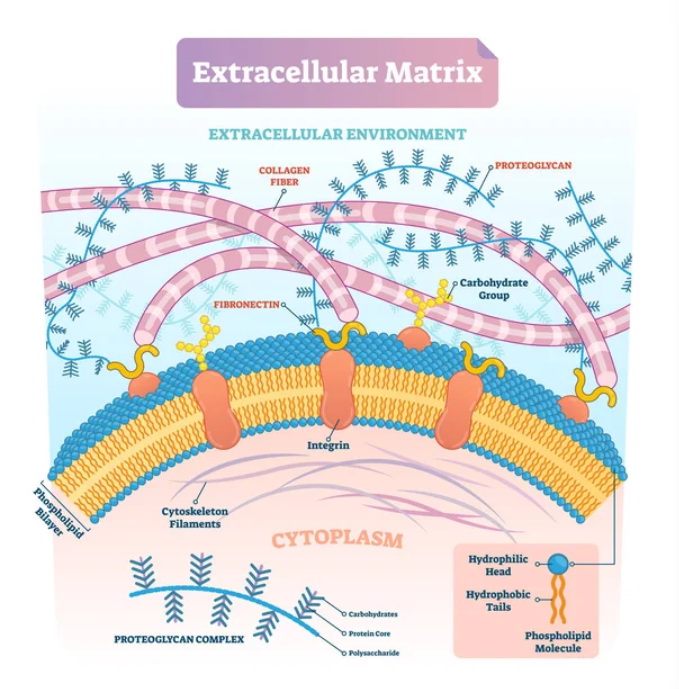Extracellular Matrix and Related Molecules
About Extracellular Matrix and Related Molecules

The extracellular matrix (ECM) is a complex network of proteins and carbohydrates that surrounds cells in tissues throughout the body. It provides structural support, biochemical signaling, and mechanical properties essential for tissue organization and function. The ECM is composed of various molecules, including proteins, proteoglycans, glycoproteins, and polysaccharides, which interact to form a dynamic and highly regulated microenvironment. Here's an introduction to the ECM and its related molecules:
Extracellular Matrix Molecules: The extracellular matrix (ECM) is a complex network of molecules that surrounds cells in tissues and provides structural support, biochemical signaling, and mechanical properties. Several important ECM molecules include collagens, elastin, fibronectin, and laminin.
Hyaluronan (HA) Binding Proteins: Hyaluronan is a large, non-sulfated glycosaminoglycan that is found in the ECM. It plays a role in tissue hydration, lubrication, and shock absorption. HA binding proteins, such as CD44 and RHAMM, interact with hyaluronan and mediate its functions. These proteins are involved in cell signaling, migration, and tissue homeostasis.
Metalloproteases and Regulators: Metalloproteases are a group of enzymes that degrade ECM components. They play a crucial role in ECM remodeling, tissue development, and wound healing. Metalloproteases are regulated by specific inhibitors known as tissue inhibitors of metalloproteases (TIMPs). The balance between metalloproteases and their inhibitors is essential for maintaining ECM integrity and function.
The Plasmin/Plasminogen and Kallikrein/Kinin Systems are involved in ECM degradation and tissue remodeling. Plasmin, derived from its precursor plasminogen, can degrade various ECM components. The kallikrein/kinin system generates bradykinin, which promotes ECM degradation and inflammation. These systems are important in processes such as wound healing, tissue repair, and inflammation.
Proteoglycan Regulators are molecules involved in the modulation and organization of proteoglycans in the ECM. They control proteoglycan synthesis, assembly, and turnover, influencing ECM structure and function. Examples of proteoglycan regulators include enzymes involved in GAG chain modification, as well as proteins that interact with proteoglycans and regulate their interactions with other ECM components and signaling molecules.
Proteoglycans are complex molecules composed of a core protein with covalently attached glycosaminoglycan (GAG) chains. They contribute to the hydrated gel-like properties of the ECM and play important roles in various physiological processes. Proteoglycans are involved in cell-matrix interactions, growth factor regulation, tissue development, and wound healing. Examples of proteoglycans include aggrecan, decorin, syndecan, and perlecan.
Understanding the functions and interactions of these ECM molecules and regulators is crucial for comprehending tissue biology, development, repair, and disease processes. The ECM provides structural support and coordinates cell behavior, ultimately influencing tissue function and homeostasis.
The Significance of Studying Extracellular Matrix and Related Molecules
Studying the extracellular matrix (ECM) and its related molecules is of great significance due to the following reasons:
Tissue Development and Homeostasis: The ECM plays a critical role in tissue development, organization, and homeostasis. Understanding the composition, organization, and functions of the ECM is essential for unraveling the mechanisms underlying tissue formation, maintenance, and repair. It provides insights into how cells interact with their surrounding matrix and how these interactions influence tissue architecture and function.
Cell Behavior and Signaling: The ECM acts as a dynamic microenvironment that regulates cell behavior and signaling. It provides physical and biochemical cues to cells, influencing processes such as cell adhesion, migration, proliferation, differentiation, and survival. By studying the ECM and its related molecules, we can gain insights into how cells sense and respond to their extracellular environment, which is crucial for understanding tissue development, regeneration, and disease progression.
Disease Pathology: Dysregulation or alterations in the ECM and its related molecules are associated with various diseases and pathological conditions. For instance, ECM remodeling plays a crucial role in tissue fibrosis, cancer invasion and metastasis, cardiovascular diseases, neurodegenerative disorders, and inflammatory conditions. Investigating the changes in ECM composition, organization, and function can provide valuable information about disease mechanisms and potential therapeutic targets.
Biomaterials and Tissue Engineering: The ECM serves as a scaffold for tissue engineering and regenerative medicine approaches. Understanding the ECM structure and composition is vital for designing and developing biomaterials that mimic the native tissue environment. By studying ECM-related molecules, researchers can create biomimetic scaffolds that promote cell adhesion, migration, and tissue regeneration.
Therapeutic Target Identification: The ECM and its related molecules offer potential targets for therapeutic interventions. By studying the ECM components, their interactions, and regulatory mechanisms, researchers can identify novel therapeutic targets for various diseases. For example, targeting enzymes involved in ECM degradation or developing strategies to modulate ECM remodeling can have implications in cancer therapy, tissue regeneration, and fibrotic diseases.
Drug Discovery and Development: The ECM and its related molecules can serve as targets for drug discovery and development. By understanding the roles of specific ECM molecules in disease processes, researchers can develop drugs that modulate their activity or interactions. Additionally, the ECM can influence drug delivery and efficacy by acting as a barrier or reservoir for therapeutic agents.
In summary, studying the ECM and its related molecules is crucial for understanding tissue development, cell behavior, disease pathology, tissue engineering, and therapeutic interventions. It provides insights into the complex interplay between cells and their microenvironment, offering opportunities for the development of novel diagnostic tools, therapeutic strategies, and biomaterials for tissue repair and regeneration.
Available Resources for Extracellular Matrix and Related Molecules
Creative BioMart provides an extensive range of products and customized services to bolster research involving the extracellular matrix and associated molecules. Our offerings encompass recombinant proteins, cell and tissue lysates, pre-coupled protein beads, antibodies, and more, all aimed at unraveling the mechanisms governing these critical protein signaling pathways.
Additionally, we furnish comprehensive resource support, encompassing pathways, protein functions, interacting proteins, related research areas, relevant articles, and other pertinent materials related to the extracellular matrix and associated molecules. Our dedication lies in furnishing top-tier research tools and services to aid in achieving successful scientific outcomes.
For further inquiries or custom services, please do not hesitate to reach out to us at your convenience.


